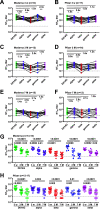Determining the Time of Booster Dose Based on the Half-Life and Neutralization Titers against SARS-CoV-2 Variants of Concern in Fully Vaccinated Individuals
- PMID: 37428104
- PMCID: PMC10434144
- DOI: 10.1128/spectrum.04081-22
Determining the Time of Booster Dose Based on the Half-Life and Neutralization Titers against SARS-CoV-2 Variants of Concern in Fully Vaccinated Individuals
Abstract
Although mRNA-based COVID-19 vaccines reduce the risk of severe disease, hospitalization and death, vaccine effectiveness (VE) against infection and disease from variants of concern (VOC) wanes over time. Neutralizing antibodies (NAb) are surrogates of protection and are enhanced by a booster dose, but their kinetics and durability remain understudied. Current recommendation of a booster dose does not consider the existing NAb in each individual. Here, we investigated 50% neutralization (NT50) titers against VOC among COVID-19-naive participants receiving the Moderna (n = 26) or Pfizer (n = 25) vaccine for up to 7 months following the second dose, and determined their half-lives. We found that the time it took for NT50 titers to decline to 24, equivalent to 50% inhibitory dilution of 10 international units/mL, was longer in the Moderna (325/324/235/274 days for the D614G/alpha/beta/delta variants) group than in the Pfizer (253/252/174/226 days) group, which may account for the slower decline in VE of the Moderna vaccine observed in real-world settings and supports our hypothesis that measuring the NT50 titers against VOC, together with information on NAb half-lives, can be used to dictate the time of booster vaccination. Our study provides a framework to determine the optimal time of a booster dose against VOC at the individual level. In response to future VOC with high morbidity and mortality, a quick evaluation of NAb half-lives using longitudinal serum samples from clinical trials or research programs of different primary-series vaccinations and/or one or two boosters could provide references for determining the time of booster in different individuals. IMPORTANCE Despite improved understanding of the biology of SARS-CoV-2 (severe acute respiratory syndrome coronavirus 2), the evolutionary trajectory of the virus is uncertain, and the concern of future antigenically distinct variants remains. Current recommendations for a COVID-19 vaccine booster dose are primarily based on neutralization capacity, effectiveness against circulating variants of concern (VOC), and other host factors. We hypothesized that measuring neutralizing antibody titers against SARS-CoV-2 VOC together with half-life information can be used to dictate the time of booster vaccination. Through detailed analysis of neutralizing antibodies against VOC among COVID-19-naive vaccinees receiving either of two mRNA vaccines, we found that the time it took for 50% neutralization titers to decline to a reference level of protection was longer in the Moderna than in the Pfizer group, which supports our hypothesis. In response to future VOC with potentially high morbidity and mortality, our proof-of-concept study provides a framework to determine the optimal time of a booster dose at the individual level.
Keywords: half-life; mRNA vaccine; neutralizing antibodies; severe acute respiratory syndrome coronavirus 2; variants of concern.
Conflict of interest statement
The authors declare no conflict of interest.
Figures




Similar articles
-
COVID-19 Vaccines.2025 Jul 15. Drugs and Lactation Database (LactMed®) [Internet]. Bethesda (MD): National Institute of Child Health and Human Development; 2006–. 2025 Jul 15. Drugs and Lactation Database (LactMed®) [Internet]. Bethesda (MD): National Institute of Child Health and Human Development; 2006–. PMID: 33355732 Free Books & Documents. Review.
-
Safety and immunogenicity of a modified mRNA-lipid nanoparticle vaccine candidate against COVID-19: Results from a phase 1, dose-escalation study.Hum Vaccin Immunother. 2024 Dec 31;20(1):2408863. doi: 10.1080/21645515.2024.2408863. Epub 2024 Oct 18. Hum Vaccin Immunother. 2024. PMID: 39422261 Free PMC article. Clinical Trial.
-
Mapping of human monoclonal antibody responses to XBB.1.5 COVID-19 monovalent vaccines: a B cell analysis.Lancet Microbe. 2025 Aug;6(8):101103. doi: 10.1016/j.lanmic.2025.101103. Epub 2025 May 30. Lancet Microbe. 2025. PMID: 40456237
-
Immunogenicity and seroefficacy of pneumococcal conjugate vaccines: a systematic review and network meta-analysis.Health Technol Assess. 2024 Jul;28(34):1-109. doi: 10.3310/YWHA3079. Health Technol Assess. 2024. PMID: 39046101 Free PMC article.
-
Establishment of human post-vaccination SARS-CoV-2 standard reference sera.J Immunol Methods. 2024 Jul;530:113698. doi: 10.1016/j.jim.2024.113698. Epub 2024 May 31. J Immunol Methods. 2024. PMID: 38823574 Free PMC article.
Cited by
-
Vaccination for solid organ transplanted patients: Recommendations, efficacy, and safety.World J Transplant. 2024 Dec 18;14(4):92172. doi: 10.5500/wjt.v14.i4.92172. World J Transplant. 2024. PMID: 39697451 Free PMC article. Review.
-
COVID-19 vaccines and beyond.Cell Mol Immunol. 2024 Mar;21(3):207-209. doi: 10.1038/s41423-024-01132-2. Epub 2024 Jan 26. Cell Mol Immunol. 2024. PMID: 38273150 Free PMC article. No abstract available.
References
-
- Johns Hopkins University Coronavirus Research Center. COVID-19 dashboard. Johns Hopkins University, Baltimore, MD. https://coronavirus.jhu.edu/map.html. Accessed 8 June 2022.
-
- WHO. 2022. Tracking SARS-CoV-2 variants. Updated June 6, 2022. https://www.who.int/en/activities/tracking-SARS-CoV-2-variants/. WHO, Geneva, Switzerland.
-
- Harvey WT, Carabelli AM, Jackson B, Gupta RK, Thomson EC, Harrison EM, Ludden C, Reeve R, Rambaut A, Peacock SJ, Robertson DL, COVID-19 Genomics UK (COG-UK) Consortium . 2021. SARS-CoV-2 variants, spike mutations and immune escape. Nat Rev Microbiol 19:409–424. doi:10.1038/s41579-021-00573-0. - DOI - PMC - PubMed
-
- CDC. 2023. The possibility of COVID-19 after vaccination: breakthrough infections. https://www.cdc.gov/coronavirus/2019-ncov/vaccines/effectiveness/why-mea.... CDC, Atlanta, GA.
-
- Tenforde MW, Self WH, Naioti EA, Ginde AA, Douin DJ, Olson SM, Talbot HK, Casey JD, Mohr NM, Zepeski A, Gaglani M, McNeal T, Ghamande S, Shapiro NI, Gibbs KW, Files DC, Hager DN, Shehu A, Prekker ME, Erickson HL, Gong MN, Mohamed A, Henning DJ, Steingrub JS, Peltan ID, Brown SM, Martin ET, Monto AS, Khan A, Hough CL, Busse LW, Ten Lohuis CC, Duggal A, Wilson JG, Gordon AJ, Qadir N, Chang SY, Mallow C, Rivas C, Babcock HM, Kwon JH, Exline MC, Halasa N, Chappell JD, Lauring AS, Grijalva CG, Rice TW, Jones ID, Stubblefield WB, Baughman A, IVY Network Investigators; IVY Network, et al. . 2021. Sustained effectiveness of Pfizer-BioNTech and Moderna vaccines against COVID-19 associated hospitalizations among adults: United States, March–July 2021. MMWR Morb Mortal Wkly Rep 70:1156–1162. doi:10.15585/mmwr.mm7034e2. - DOI - PMC - PubMed
Publication types
MeSH terms
Substances
Supplementary concepts
Grants and funding
LinkOut - more resources
Full Text Sources
Medical
Research Materials
Miscellaneous

